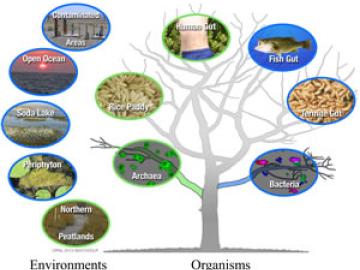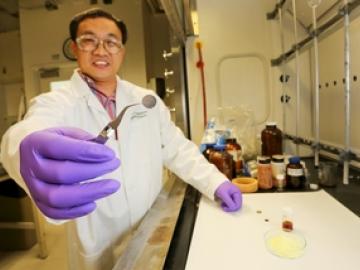Filter News
Area of Research
- (-) Clean Energy (167)
- (-) Fusion Energy (2)
- (-) Materials (204)
- Advanced Manufacturing (13)
- Biological Systems (14)
- Biology and Environment (40)
- Biology and Soft Matter (1)
- Building Technologies (3)
- Chemistry and Physics at Interfaces (4)
- Climate and Environmental Systems (2)
- Computational Biology (4)
- Computational Engineering (2)
- Computer Science (4)
- Energy Frontier Research Centers (7)
- Energy Sciences (2)
- Fossil Energy (2)
- Fuel Cycle Science and Technology (1)
- Functional Materials for Energy (6)
- Fusion and Fission (17)
- Geographic Information Science and Technology (2)
- Isotope Development and Production (1)
- Isotopes (8)
- Materials Characterization (2)
- Materials for Computing (13)
- Materials Synthesis from Atoms to Systems (5)
- Materials Under Extremes (5)
- National Security (24)
- Neutron Science (77)
- Nuclear Science and Technology (24)
- Nuclear Systems Modeling, Simulation and Validation (1)
- Nuclear Systems Technology (1)
- Quantum Condensed Matter (1)
- Quantum information Science (1)
- Reactor Technology (1)
- Sensors and Controls (1)
- Supercomputing (107)
- Transportation Systems (5)
News Type
News Topics
- 3-D Printing/Advanced Manufacturing (33)
- Advanced Reactors (4)
- Artificial Intelligence (6)
- Big Data (1)
- Bioenergy (17)
- Biology (6)
- Biomedical (4)
- Biotechnology (2)
- Buildings (8)
- Chemical Sciences (20)
- Clean Water (1)
- Climate Change (8)
- Composites (6)
- Computer Science (13)
- Coronavirus (4)
- Critical Materials (10)
- Cybersecurity (4)
- Decarbonization (11)
- Energy Storage (36)
- Environment (17)
- Exascale Computing (2)
- Fossil Energy (1)
- Frontier (2)
- Fusion (4)
- Grid (10)
- High-Performance Computing (4)
- Isotopes (5)
- ITER (1)
- Machine Learning (5)
- Materials (44)
- Materials Science (39)
- Mercury (1)
- Microscopy (12)
- Molten Salt (2)
- Nanotechnology (22)
- National Security (5)
- Net Zero (1)
- Neutron Science (23)
- Nuclear Energy (6)
- Partnerships (11)
- Physics (14)
- Polymers (9)
- Quantum Computing (1)
- Quantum Science (10)
- Renewable Energy (1)
- Security (3)
- Simulation (1)
- Summit (3)
- Sustainable Energy (25)
- Transformational Challenge Reactor (3)
- Transportation (18)
Media Contacts

Gas and oil deposits in shale have no place to hide from an Oak Ridge National Laboratory technique that provides an inside look at pores and reveals structural information potentially vital to the nation’s energy needs.

Oak Ridge National Laboratory's Center for Computational Sciences is using supercomputers to design better and less expensive solar panels that can capture the sun’s rays more efficiently and maximize power production.

Microbes that live in rice paddies, northern peat bogs and other previously unexpected environments are among the bacteria that can generate highly toxic methylmercury, researchers at Oak Ridge National Laboratory and the Smithsonian Environmental Research Center have learned.
Better batteries, catalysts, electronic information storage and processing devices are among potential benefits of an unexpected discovery made by Oak Ridge National Laboratory scientists using samples isolated from the atmosphere.

More forms of mercury can be converted to deadly methylmercury than previously thought, according to a study published Sunday in Nature Geoscience.

Scientists at the Department of Energy's Oak Ridge National Laboratory have designed and tested an all-solid lithium-sulfur battery with approximately four times the energy density of conventional lithium-ion technologies that power today's electronics.




